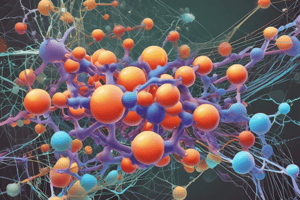Podcast
Questions and Answers
Which method is considered the most reliable for assessing dietary intake of pantothenic acid?
Which method is considered the most reliable for assessing dietary intake of pantothenic acid?
- Blood levels
- Urine levels (correct)
- Plasma levels
- Serum levels
What is the recommended daily allowance (RDA) of biotin for adults?
What is the recommended daily allowance (RDA) of biotin for adults?
- 8 µg
- 30 µg (correct)
- 12 µg
- 20 µg
Which food source is NOT a recognized source of biotin?
Which food source is NOT a recognized source of biotin?
- Liver
- Soybean products
- Egg yolk
- Beef (correct)
What is the standard oral dosage for pantothenic acid treatment?
What is the standard oral dosage for pantothenic acid treatment?
Which of the following actions is NOT associated with biotin?
Which of the following actions is NOT associated with biotin?
What are the potential chronic effects of excessive vitamin C intake?
What are the potential chronic effects of excessive vitamin C intake?
What is the recommended daily intake of vitamin C for adults to prevent scurvy?
What is the recommended daily intake of vitamin C for adults to prevent scurvy?
Which of the following foods should be encouraged for high vitamin C intake?
Which of the following foods should be encouraged for high vitamin C intake?
What is the management approach when vitamin C toxicity is suspected?
What is the management approach when vitamin C toxicity is suspected?
Which condition has inconclusive evidence regarding the protective role of vitamin C in its management?
Which condition has inconclusive evidence regarding the protective role of vitamin C in its management?
What is a rare cause of biotin deficiency?
What is a rare cause of biotin deficiency?
Which symptom is associated with biotin deficiency?
Which symptom is associated with biotin deficiency?
Which of the following is a sign of vitamin C deficiency?
Which of the following is a sign of vitamin C deficiency?
What is the recommended treatment for biotin deficiency?
What is the recommended treatment for biotin deficiency?
Where is vitamin C primarily absorbed in the body?
Where is vitamin C primarily absorbed in the body?
What is the significance of NAD and NADP in biochemical reactions?
What is the significance of NAD and NADP in biochemical reactions?
Which food source is NOT rich in vitamin B3 (niacin)?
Which food source is NOT rich in vitamin B3 (niacin)?
How much tryptophan is needed to produce 1 mg of niacin?
How much tryptophan is needed to produce 1 mg of niacin?
What is the Recommended Dietary Allowance (RDA) for niacin in adult females?
What is the Recommended Dietary Allowance (RDA) for niacin in adult females?
Which of the following is NOT a known cause of pellagra?
Which of the following is NOT a known cause of pellagra?
How does the body convert tryptophan into niacin?
How does the body convert tryptophan into niacin?
Which condition is associated with diversion of tryptophan metabolism away from niacin production?
Which condition is associated with diversion of tryptophan metabolism away from niacin production?
What does the term 'pellagra' literally translate to?
What does the term 'pellagra' literally translate to?
What are the four primary clinical features associated with Pellagra?
What are the four primary clinical features associated with Pellagra?
Which skin manifestation is specifically associated with Pellagra?
Which skin manifestation is specifically associated with Pellagra?
What gastrointestinal symptoms are typically seen in Pellagra?
What gastrointestinal symptoms are typically seen in Pellagra?
What kind of neurological symptoms may occur in severe cases of Pellagra?
What kind of neurological symptoms may occur in severe cases of Pellagra?
How is the diagnosis of Pellagra confirmed?
How is the diagnosis of Pellagra confirmed?
What is the typical treatment regimen for someone diagnosed with Pellagra?
What is the typical treatment regimen for someone diagnosed with Pellagra?
What is a rare clinical manifestation of Pantothenic acid deficiency?
What is a rare clinical manifestation of Pantothenic acid deficiency?
Which dietary sources are rich in pantothenic acid?
Which dietary sources are rich in pantothenic acid?
What is the recommended dietary intake for pantothenic acid for adult men and women?
What is the recommended dietary intake for pantothenic acid for adult men and women?
What condition may present in mild deficiency of pantothenic acid?
What condition may present in mild deficiency of pantothenic acid?
What is the primary cause of scurvy?
What is the primary cause of scurvy?
Which population is at the highest risk of vitamin C deficiency?
Which population is at the highest risk of vitamin C deficiency?
Which of the following is NOT a symptom of adult scurvy?
Which of the following is NOT a symptom of adult scurvy?
What characterizes hemorrhages in scurvy?
What characterizes hemorrhages in scurvy?
What is a reliable laboratory finding for diagnosing vitamin C deficiency?
What is a reliable laboratory finding for diagnosing vitamin C deficiency?
Which condition requires increased intake of vitamin C?
Which condition requires increased intake of vitamin C?
What symptom can be observed in both adult and infantile scurvy?
What symptom can be observed in both adult and infantile scurvy?
Which of the following is typically associated with infantile scurvy?
Which of the following is typically associated with infantile scurvy?
Which dietary habit increases the risk of vitamin C deficiency in the elderly?
Which dietary habit increases the risk of vitamin C deficiency in the elderly?
What is a common cutaneous presentation of scurvy?
What is a common cutaneous presentation of scurvy?
Flashcards are hidden until you start studying
Study Notes
Pantothenic Acid (Vitamin B5)
- Diagnosis involves evaluating blood, plasma, serum, or urine levels; urine levels preferred for dietary intake assessment.
- Management includes a daily oral dosage of 5 mg of pantothenic acid.
Biotin
- Key sources: Liver, egg yolk, soybean products, yeast.
- Essential cofactor for carboxylase enzymes in carbohydrate, amino acid, and lipid metabolism.
- Recommended daily allowance (RDA): 8-12 µg daily for children, 30 µg daily for adults.
Vitamin B3 (Niacin)
- Sources include yeast, meats (especially liver), grains, legumes, corn, and seeds.
- Tryptophan can be converted to niacin; requires 60 mg tryptophan for 1 mg niacin along with vitamin B6.
- NAD/NADP function as cofactors in enzymatic redox reactions.
- RDA is measured as niacin equivalents (NE): 6-12 mg for children, 16 mg for adult males, and 14 mg for nonpregnant females.
Pellagra
- Caused by niacin deficiency, resulting in a metabolic encephalopathy.
- Common in regions where corn is a major dietary staple, such as parts of China, Africa, and India.
- Four D's of Pellagra: Dermatitis, Diarrhea, Dementia, Death, although not always observed.
- Skin manifestations include Casal's necklace, with rashes developing from sun exposure.
Causes of Pellagra
- Inadequate intake from maize or jowar diets, malnutrition, chronic alcoholism.
- Rare generalized malabsorption.
- Drug-induced causes (e.g., prolonged isoniazid therapy, certain chemotherapeutics).
- Other disorders, such as Hartnup's disease or carcinoid syndrome, divert tryptophan away from niacin production.
Vitamin C (Ascorbic Acid)
- Toxicity can be acute or chronic; acute toxicity linked to doses over 2g, causing abdominal issues.
- Chronic effects may include kidney stones, iron overload, hemolysis in G6PD deficiency, and interference with drug efficacy.
- Recommended dietary intake: 120 mg daily for adults, with 60 mg required to prevent scurvy.
- High Vitamin C intake may lower the incidence of gastric and esophageal cancers.
Clinical Features of Pellagra
- Chronic deficiency can lead to skin, gastrointestinal, and neurological symptoms.
- Dermatological symptoms include hyperpigmentation and skin lesions.
- Gastrointestinal issues can manifest as diarrhea, glossitis, and dysphagia.
- Neurological symptoms range from depression to hallucinations and confusion.
Diagnosis and Management
- Diagnosis reliant on clinical features; rapid improvement with niacin treatment is notable.
- Niacin status is assessed through urinary metabolites or erythrocyte NAD:NADP ratios.
- Treatment for niacin deficiency typically includes nicotinamide at 100-200 mg, with dietary changes recommended.
Vitamin B12 and Folic Acid
- Further details addressed in Chapter 8.
Biotin Deficiency
- Rare but can arise from long-term parenteral nutrition or excessive raw egg white consumption.
- Clinical symptoms may include dermatitis, conjunctivitis, and neurological changes.
- Diagnosis involves measuring urine biotin concentrations and enzyme activity.
Vitamin C Deficiency (Scurvy)
- Scurvy is primarily due to insufficient Vitamin C intake.
- High-risk groups include infants on inadequate diets, individuals with chronic diseases, and those lacking vegetable intake.
- Symptoms of scurvy comprise malaise, weakness, hemorrhages, and emotional changes.
Scurvy Types and Symptoms
- Adult scurvy: Symptoms include fatigue, pain, easy bruising, and bleeding gums.
- Infantile scurvy (Barlow's disease): Notable for subperiosteal hemorrhages and skeletal changes.
Studying That Suits You
Use AI to generate personalized quizzes and flashcards to suit your learning preferences.




